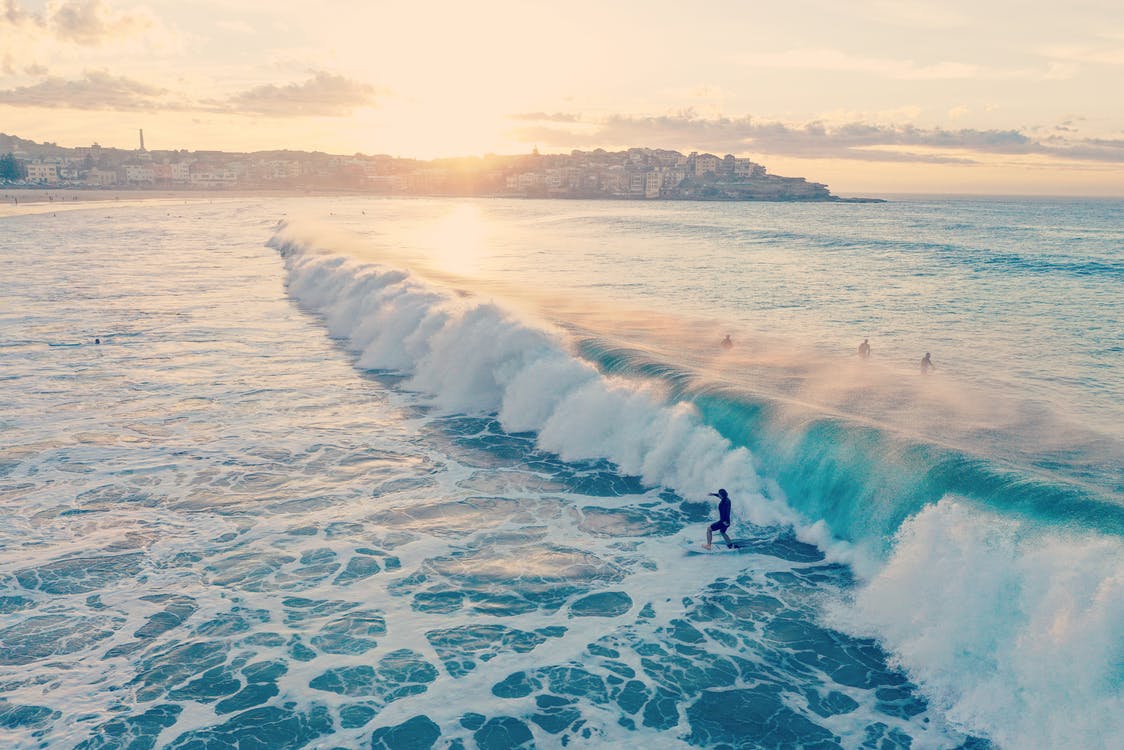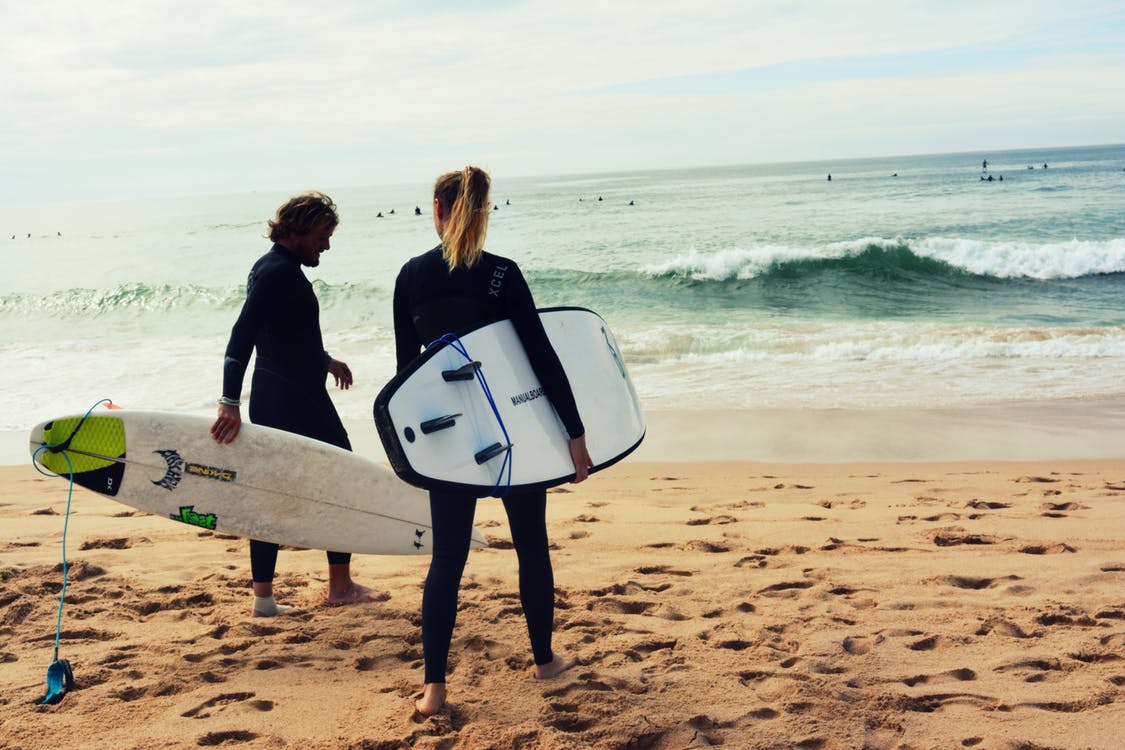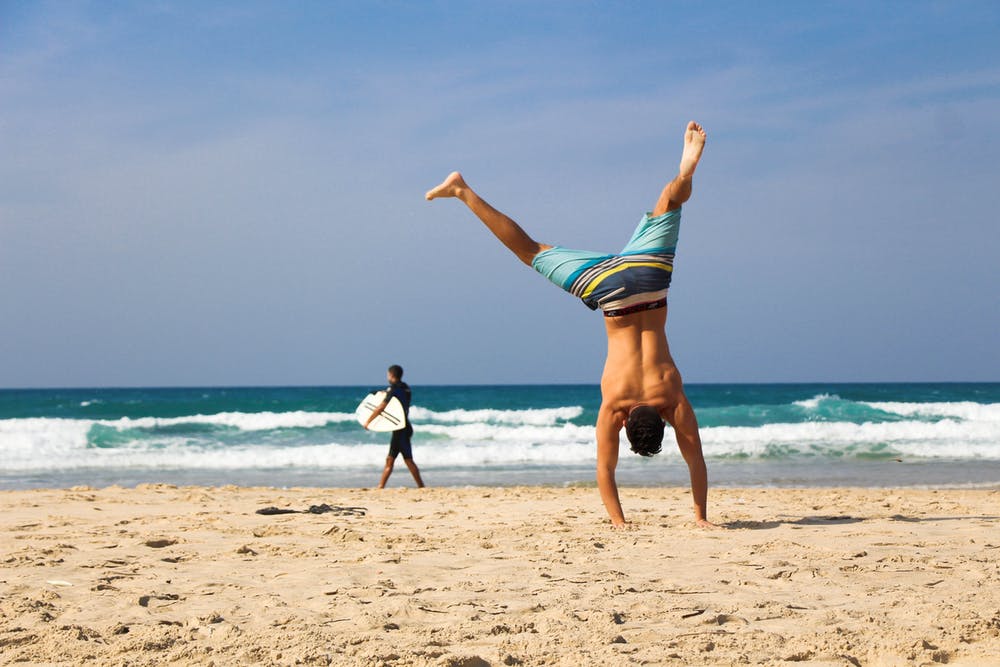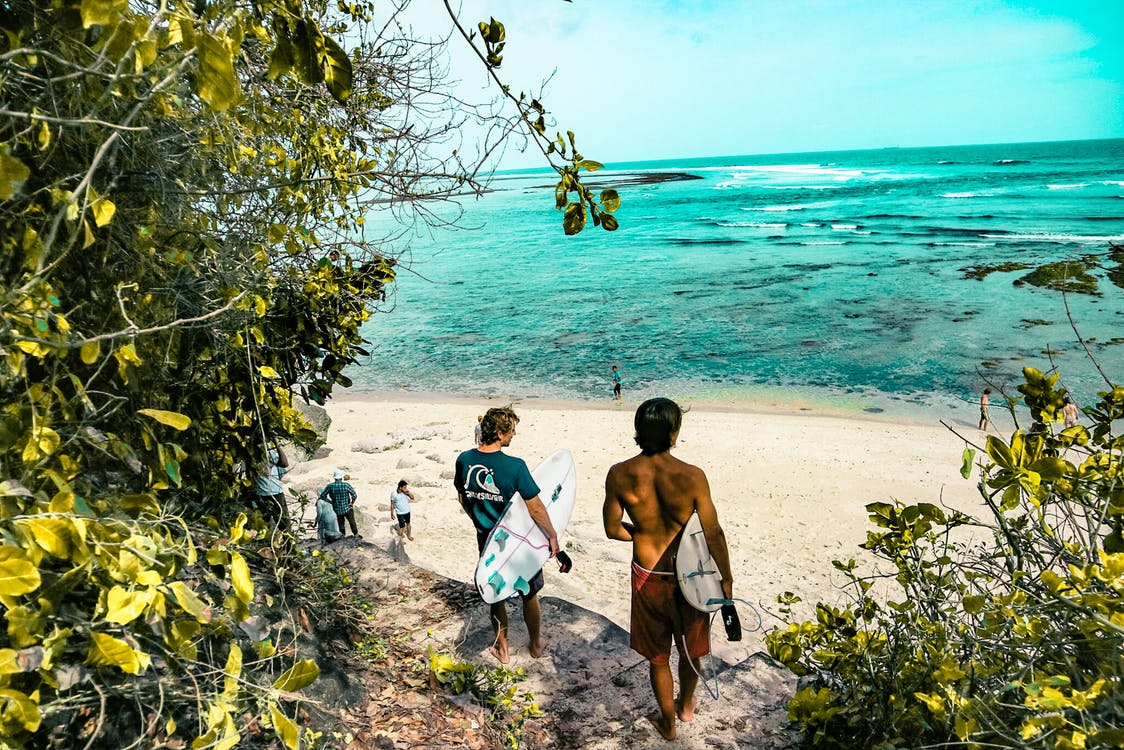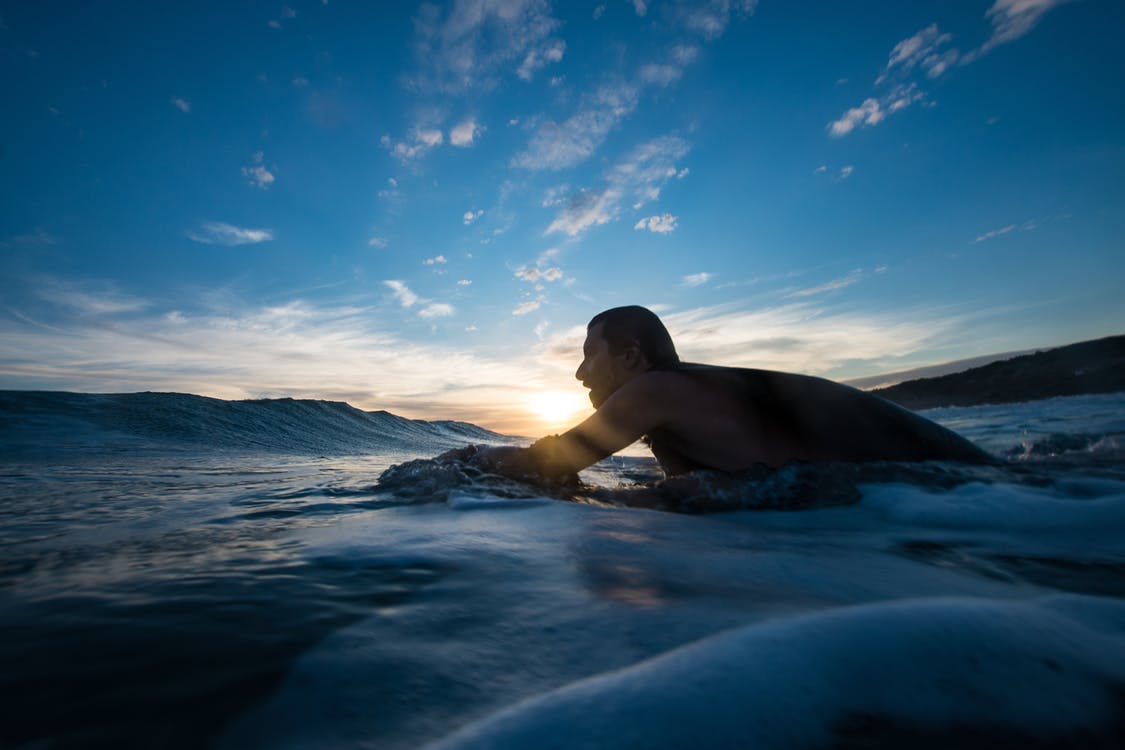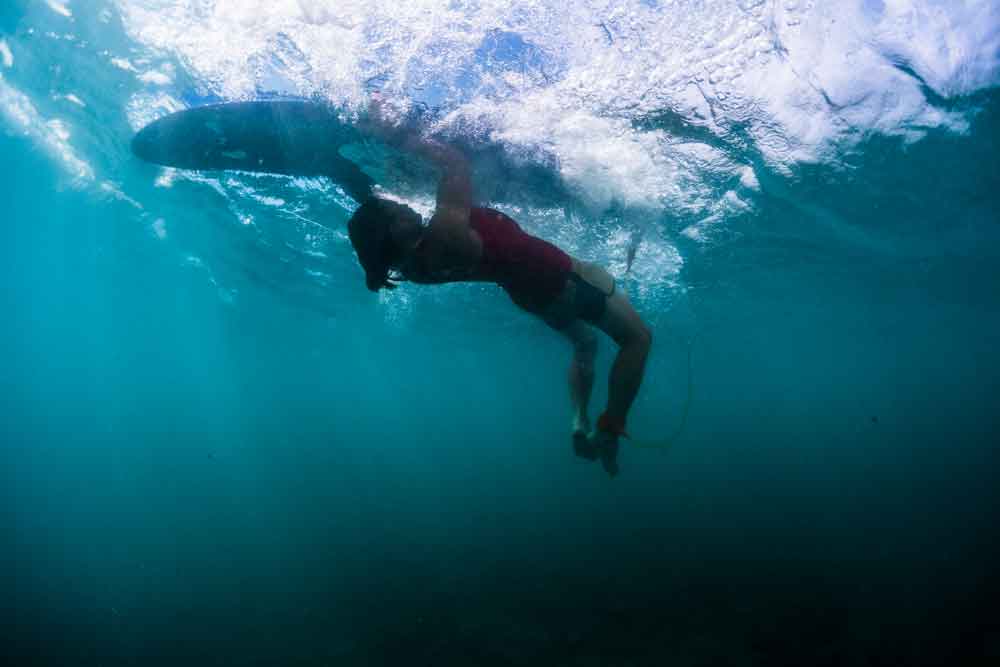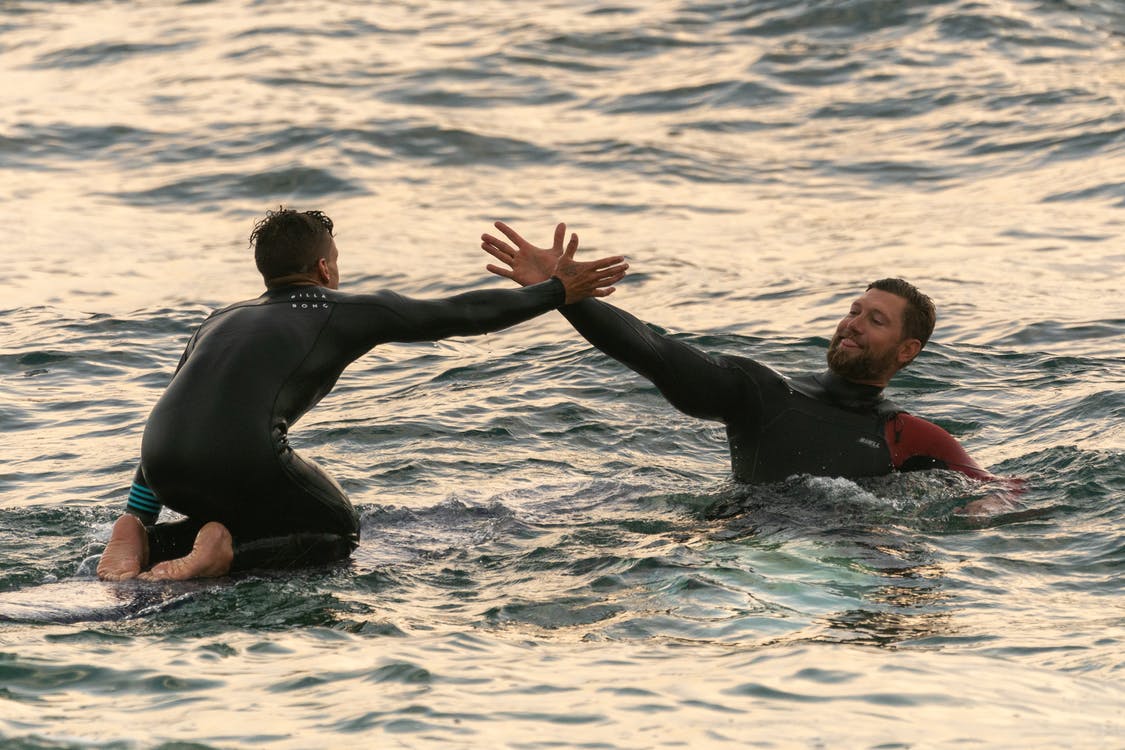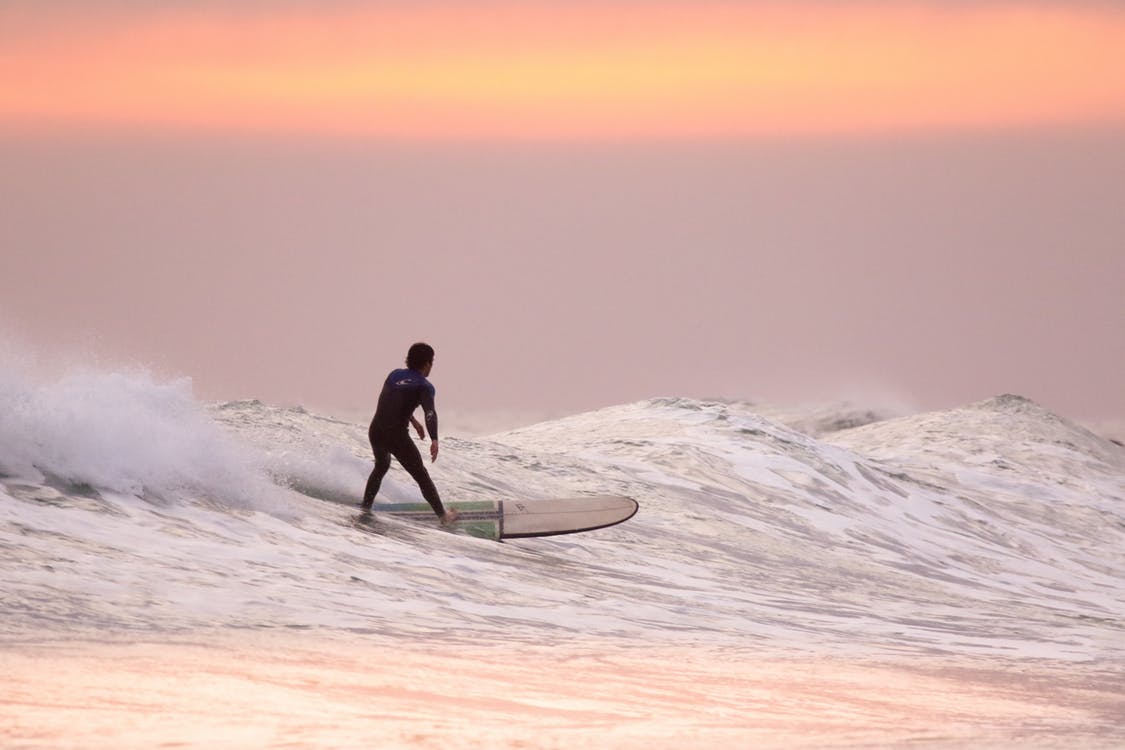
22 Aug How to surf ? | 8 Surfing tips for beginners
How To Surf?
Learning how to surf on your own is not easy. Surfing is nothing like other more traditional sports. The learning curve is slow but that’s also what makes it fun.
Even after 10 years of surfing, you will still be challenged to improve on something in every session. And surfing is probably the only extreme sport that you will manage to do in your 60s, so start investing now on the learning process!
Unlike other sports, surfing is practiced in an unpredictable environment and largely depends on climatic and geographical conditions. Above all, we have to share our playground with other surfers. In essence, you cannot learn how to surf at the same ease, as you would learn how to play football or tennis.
Surfing for beginners 101
Here’s what every beginner surfer should know to learn how to surf:
1- Understanding Your Environment
2- Being In Good Physical Shape
3- Learning How To Paddle
4- How To Pop Up On A Surfboard
5- How To Catch A Wave
6- Passing The Break: Turtle Roll and Duck Dive
7- Understanding Surfing Etiquette
8- Use the right Surf Equipment
1. Understanding your environment
Finding the right spot to learn how to surf
We strongly suggest getting a few surf lessons before going on your own. Or at least going with someone of experience: they will be able to provide you with proper advice that will keep you and the people around you safe. It’s also a good idea to check Surfline or another surf forecasting site to make sure the waves won’t be too big when you paddle out.
Make sure that your friend stays next to you during the session and does not leave you behind while he goes surfing further at the peak.
One of the beginner surf spots where we host surf retreats in Costa Rica.
The waves are long and not too strong, perfect to learn to catch unbroken waves without many consequences.
Once you’re up on the wave, you can correct your position and movements while surfing the same wave. It creates many of those HA-HA moments.
Find out if the waves are the right size for you.
The risk of ending up in the water and losing the board is always lurking. As a rule of thumb, do not go in the water if you judge that you would not be able to swim back to shore if you lost your board.
Look at the wave before going in
Can you tell which kind of surfers is in the water? Are they mainly very experienced surfers? Maybe there is a reason why… Are there a few beginners? How are they managing the wave? Where will you be sitting in the water? Are there any rip currents?
Any surfer in the know who respects the ocean will take a good 10 minutes to observe the spot before going surfing in a new place. This will allow you to notice who are the locals, what are the dangers, and if this spot is the right one for you.
Finding the right board for you
If you are just starting to surf, you will probably want to rent a board for at least the first 10 times to figure out what kind of board you like and how much volume works for your paddling abilities and weight. Find a spot that has a local surf shop that rents equipments and ask them to help you choosing the right board for you. Your can also read more about how to find the right board for you with our Beginner Longboard Guide.
2. Being in good physical shape
Surfing is a tough sport that can help you build muscles, lose weight, and burn calories very fast.
Overall, it is a demanding sport that requires you to be able to swim in the open sea when the waves are high, to get back on your surfboard while being pushed by the water, and to stay balanced on the board in precarious conditions.
To be able to sprint your paddle to catch waves and paddle out of the impact zone, paddle back to the peak and push yourself up on the board, you need to be in decent physical shape, so you must make sure you are physically fit to doing high endurance sports.
Since it’s impossible to become fit from one day to another: start training as soon as possible. If you leave everything until the last minute, you certainly can’t expect miracles.
Which muscles does surfing work?
Biceps and Triceps
The biceps and triceps are two of the main muscles you need to train if you want to become a good surfer. These muscles are mainly used to help your body rise properly and stand on the surfboard.
Also, biceps and triceps help you paddle with strength as soon as the wave is coming.
Abs
Abs are very important when you are lying on your surfboard. They allow you to lie down more comfortably, facilitating all the movements that are needed for paddling and standing on the surfboard.
Shoulders, dorsals, and pectorals
These three muscles are also essential for surfing. They help you swim, paddle, and lift yourself when you’re about to ride a wave.
Legs
Legs are extremely important if you want to maintain a good standing position on the surfboard. Once you manage to lift yourself on the board thanks to your biceps and triceps, it is essential to be able to keep balance with your legs whilst you are in a semi-erect position.
Cardio
Swimming is fundamental to maintain the toned shape that your body needs when facing the stormy sea, the currents, and the waves. Swimming against the waves, and then swimming to catch other waves, is very tiring.
It is obvious that to be a surfer, you will also need to be a good swimmer, so go swimming regularly in the local pool.
Yoga
Surfing and mindfulness go hand in hand. So why not try another meditative practice? Yoga is great for surfers, and can play a key role in your training it can provide you with good balance and focus.
3. Learning How To Paddle
To paddle, lay down in the middle of your surfboard. To be able to do this, you will need some practice. Initially, you could position yourself incorrectly and end up placing too much weight on the nose or the tail of the surfboard (causing it to sink beneath the water level).
No worries, this is a common mistake: if you lie too much at the bottom of the board, you will end up dragging the surfboard rather than gliding the water. You will, therefore, need to experiment a little to find an adequate way to distribute your weight.
If you position your body closer to the nose of the surfboard, the nose will go beneath the water level and as a consequence, you will end up sliding off your board. So here are some proper surfing tips to keep in mind:
- Once you’re lying down on the board, slightly move downwards so that the tip of the surfboard is lifted
- Remember to keep your chest elevated so that it doesn’t touch the board
- Form a 90-degree angle with your elbow: this will allow you to paddle and dig deeper into the water
- Keep your feet out of the water in order not to create resistance when you are paddling.
- While you are on the boards, keep your legs and feet together
- To maintain equilibrium, you must stay centered on the board and be able to balance your weight on the board carefully
- Paddle with one arm at a time and make sure to finish each paddle as far behind as you can (be careful not to do half paddles).
Do not cup your hand when paddling back to the line-up. Instead, keep your hands relaxed and straight (just as you would do when swimming).
4. Learning How to Pop Up on A Surfboard
Learning to stand up on your surfboard is what every beginner surfer desires. First, you will need to discover whether you are a regular or goofy surfer.
How do you find out? Although you may still not know, being a regular or a goofy surfer will be determined by your instincts. Use the following method:
- Think about when you slip on an icy or slippery surface.
- When you slip, which foot do you put first?
- If you put your left foot first, then you are a regular surfer.
- If you put your right foot first, you are a goofy surfer.
So, How Do You Pop Up?
The Pop-up movement consists in going from a paddle position (when you are lying down on your surfboard) to the standing position. If it’s your first time doing a Pop-up, practice on the beach.
Here are some instructions that can help you stand up on your board:
- Align your hands next to your rib cage with your palms flat on the deck of the board (not grabbing the rails)
- Place your back foot above the trackpad or the fin at the back of your board sideways with the board (make sure it’s not pointing toward the nose of the board)
- Push yourself upwards using your arms and that foot to bring your front leg as far as you can between your hands.
Special Tip: Fix a point at the horizon, like the top of a tall tree, to help you keep your balance.
Practice makes perfect: once you’ve practiced this on the beach for a few times, you will be ready to try it out in the water.
However, if you are having some difficulty with this technique, here is a different solution that can help you stand up:
- While lying down, place your hands on the top of the surfboard
- Push yourself up and pull your legs behind you, to slide your feet at the right spot (back foot where the rear fin is, front foot around the middle of the board)
- Do this sideway, not facing the front like if you were climbing a ladder. Make sure to turn your body to the correct angle.
- When your feet are firmly planted, stand up slowly but keep your knees bent to be stable on the board.
5. How to catch a wave
If you are just starting as a surfer, aim for the smaller waves. Stay closer to the shore since larger waves can be dangerous and require a certain level of experience.
Remember to keep things fun (and safe!): it is not worth risking your life or putting yourself in difficulty. Learning a new skill takes time and practice: however, you will soon be able to ride cooler waves.
How do you catch a wave?
1. All you need to do is turn the board in the direction of where the wave is breaking
2. Visualize where the wave is jacking up before breaking. This is where you want to be.
3. Make sure you have priority on that wave (meaning nobody is paddling for the same wave above you in the line up)
4. Have a quick look at where you will be dropping the wave to make sure nobody is in your way.
5. At this moment you are paddling as hard as you can to get the same speed as the wave.
6. You are paddling with a little 15-degree angle towards where the wave is going, not straight to shore
7. Your chest is up so that you’re using your back muscles to paddle, which are stronger than your triceps or shoulders. (Imagine a wire pulling up your head to the sky). This means you’re paddling with your back arched up.
8. Keep looking back at the wave to make sure you are still in the right spot.
9. Look left and right to make sure nobody is coming your way already surfing the wave, or someone more experienced on your other side is also dropping that same wave. Look where you think you will be going down the wave to anticipate any possible collision.
Note: if you think that there’s any slim chance of running into someone, stop paddling, quickly sit down on your board and pull the rails hardly back towards you to get out the wave and cancel the drop, turn your head back toward the horizon and try to position yourself for the next wave coming, paddling a bit more down the line to avoid the person sitting at the wrong spot – in your way.
Make sure to tell that person to move out of the way so that he or she doesn’t blow up your other wave.
10. Nobody in the way? Perfect! As you feel the wave is just about to touch your feet or your board, shift your weight forward by bringing your chin close to the board. By doing this, your board should “click” with the wave and the wave should catch your board.
3 possible things can happen at this moment…
#1 You stand up only to realize that the wave is passing you by and haven’t taken you with it.
Why?
A) Timing: You haven’t paddle hard or fast enough and while you felt the wave was under your board, you stood up too early.
How to correct this? Keep paddling until you feel the wave is taking you and making you accelerate without you having to paddle anymore.
B) Body position: you were laying too far back on your board.
How to correct this? Try shifting your position one inch higher on the board for the next wave and see what happens.
#2 As the wave takes you and you try to stand up, you realize with horror that your nose is digging in the water (nose diving) which makes you fall in front of your board, do a cartwheel or what we commonly call the scorpion.
Why?
Body position: you were laying too far forward on your board.
How to correct this? Try shifting your position one inch lower on the board for the next wave.
Safety tips: If this happens, make sure you protect your head with your arms under the water (since there might be rocks or it might be shallow).Stay in that position: the nose of the board sunk deep in the water, will jump up in the air, and fall again.
When this happens, you want to make sure that it does not fall on your head. This is why you should stay a few seconds underwater: to protect your head and to ensure that when you come back up, your board has fallen back down.
As you’re coming up, have your arms protecting your head, get your board and hop back on as fast as you can. Get out of the impact zone and paddle back to the line-up. Reposition your body one inch further back and try again.
If it happens again, try not to shift your weight forward before doing the pop-up. Just keep your back arched all the time and pop up. It’s possible that the wave you’re surfing, especially if it’s a beach break, is jacking up fast and you can do your take off without bringing your chin to your board.
If you feel you’re about to nosedive again, grab your rails and push your board away from you. You might save yourself a fall and go down the wave surfing the tail of the board.
#3 You stand up, fix your eyes to one point to stay balanced, stay low on your board, and bend your knees. As you feel this incredible acceleration on the water, slide the wave with a grin and remember this moment for the rest of your life. Congratulation! You’re surfing!
Note on board size: Keep in mind that the longer your board is, the easier it will be to float, maintain stability, and catch a wave. Catching as many waves as you can is the most important thing to improve your surf technique. So don’t go down in size too quickly. Embrace the learning process on a longboard, and have fun!
Safety Tip: Never ditch your board!
It’s within your interest to keep your board as close as you can to you since it could hurt you or fellow surfers.
If a big wave comes, it can be tempting to ditch the board and hide under the water but this could lead to the leash breaking, you losing your board or worst, your board hitting that person paddling a few meters behind you.
On some really rare occasions, when the wave is about to break exactly where you are, and if there is absolutely nobody around you, then you may have to ditch your board. Other than on this particular occasion, you should never ditch your board.
(click here to find out more about our surf coaching retreat for beginner and intermediate surfers in Costa Rica)
6. Passing the Break
For Beginner surfers on a longboard: How to Turtle Roll
If you see a big wave coming toward you, paddle faster up to the wave and let out all the air you have in your lungs, and take one big breath. Your board should be exactly perpendicular to the wave.
You will need to grab the rails of your board and keep it close to your body. Take a deep breath and flip the board underwater. You will remain there until the wave comes over the top of the board. Once it passes, you come back up, get back on your board, and get ready to paddle into the next wave.
Tips for a successful turtle roll:
- Keep your elbows bent: if you flip over and have your arms fully extended, the wave will most likely pull the board away from you. On the other hand, if you keep your elbows bent, you will have enough room to move your arms while you are underwater. In such a way, you will be able to maintain the surfboard under control.
- You should not wrap your legs around the board: all you want to do is keep a tight grip with your hands and arms.
When is it useful to turtle roll? When you see a surfer coming towards you and you are afraid he’s going to hit you. Instead of ditching your board, grab hold of it and do a turtle roll: the board will protect you while you are underwater.
For Intermediate surfers on a shortboard: How to Duck Dive
Duck diving is an essential maneuver that any shortboard surfers need to know. When surfers duck dive, all they do is essentially dive under the wave to get to the lineup.
Going under the wave allows surfers not to be pushed back to the shore by the wave’s force. The bigger and the more potent the waves, the more important this skill becomes. You need to know how to duck dive if you are planning on becoming a good surfer.
You can learn how to duck dive through a lot of practice. When is the best time to practice? When the waves are small: if you learn the mechanism and the correct technique, you will be able to do it also in the context of bigger waves.
If you are learning how to duck dive when the waves are big, stay as close as possible to your surfboard so that you don’t need to swim back to recover it.
When duck diving you need to make sure that you are paddling towards the wave. Once you have some speed paddling toward the wave and you’re about 3 meters before the wave hits you…
(make sure you take a deep breath just before you’re about to immerse yourself in the wave)
1. Use both hands to grab the rails (edges) of the surfboard and push down by shifting your weight towards the top of your board, so that you sink the surfboard’s nose underwater
2. Then with your back foot push the tail in the water, use your other foot to push up in the air to help you sink the board and keep your balance while pushing the board underwater.
(the wave is then passing on top of you while you are underwater)
Special Tip: While underwater, use your right hand to grab the right rail and manage your board and use your left hand to give a good solid stroke or 2 to help you cover distance while that wave is passing above you.
3. Come up from the water. If you have executed the duck diving technique to perfection, then you should be able to keep paddling again as soon as you come up. It is all a matter of keeping a perpendicular angle with the wave.
If you’re a skateboarder, imagine an Ollie sequence. However, if you’re a surfer, you will need to sink your board as deep as you can in the water instead of bringing it up in the air.
If you’re a visual learner, Kale Brock has a great video tutorial on how to duck dive.
Start by practicing on small waves: you will need to become familiar with the surfboard and the waves. In fact, before being able to catch a wave, you will need to know how to paddle, and how to maintain balance. Only then will you be able to move onto the next step.
Remember that falling off the surfboard frequently is only part of the process: you will need to fail to succeed and to refine your technique. These experiences will allow you to build your confidence as a surfer.
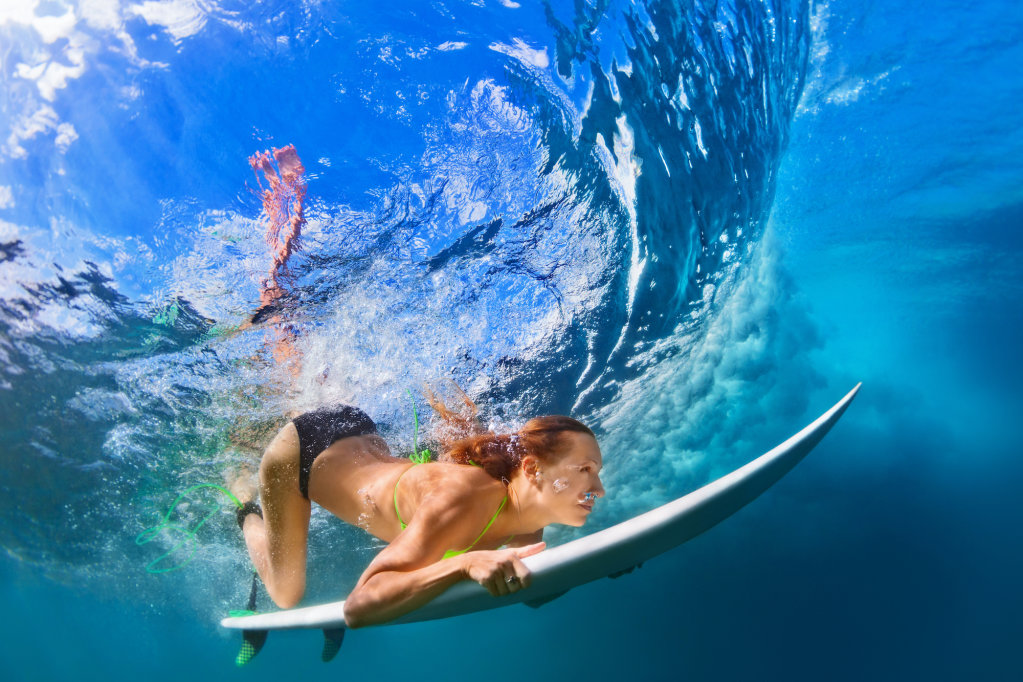 7. Understanding Surfing Etiquette
7. Understanding Surfing Etiquette
If you are a surfing newbie, you may not know about the existence of surfing etiquette. What is it? It is a set of rules that should be observed while surfing. It should always be kept in mind that surfing is a dangerous sport that is practiced in the open sea – often in difficult conditions and dangerous tides. If you want to surf safely, you need to know some of the most basic rules. The primary goal of surf etiquette is that of being courteous and keeping everyone safe.
- You should not take off in a wave that someone else is riding: if you try and catch a wave while someone else is coming towards you, the pointy end of their surfboard could potentially hurt you (and the person tiding the wave) quite badly. Therefore, if someone is on the inside or the peak of the wave, let them ride the wave. Catch the next one!
- If you are paddling out and someone is already riding a wave in front of you, the safest thing you can do is paddle towards the whitewater. This will shield you from any danger, it will stop their board from hitting you, and it will give the other person the chance to surf the wave.
- Don’t snake. Snaking is essentially wave stealing. It relates to paddling up to another surfer and taking their position. If you are snaking, it may cause other surfers to get annoyed since it is viewed as a very disrespectful and un-cool thing to do.
- When you’re in the water, avoid having someone in front of you. Likewise, check that there are no other surfers behind you.
- When you are entering the water, hold the surfboard on your side. It may seem bogus, but holding your board in front of you is risky: people have broken their nose due to waves that have pushed the surfboard onto their faces.
- When you fall, remember to protect your head with your arms, and stay underwater for a few seconds.
- You should never surf immediately after a meal: wait at least half an hour.
- If you see surfers in danger, help them.
- Respect the environment, respect the beach, and respect the locals.
For more depth into surf etiquette, read Surf Etiquette and safety: A must have handbook.
8. Having the proper surf equipment
Sure you could buy a cheap Wavestorm foam board at Costco and start on that, which wouldn’t be the best option, but it would be the cheapest, short term. For the best option, we have a whole guide on choosing your first longboard to help you find a high-quality board that works well for you.
As soon as you are able to stand up, we would recommend instead to rent different types of boards are your local surf shop to see what you like and what suits you best, before committing to buying a board. If you’re curious about how much it’ll cost to buy a board, check out our guide that breaks down exactly how much surfboards cost.
But there is more to surf equipment than just the surfboard.
If you are surfing cold water, you’ll need to buy or rent a wetsuit.
If you are surfing in a tropical country, you’ll need sun protection gear such as a surf hat, zinc, strong sunscreen, a long sleeve rash guard and even surf leggings if your skin is sensitive to the sun and you want to prevent burning behind your legs.
Check our Surf Gear Essential Guide for 2024 for more information on getting the proper surf equipment.
A Final Word
Becoming a surfer means embracing a particular lifestyle that combines healthy habits and exercising.
The main ingredients you need to be a successful surfer are
- good mental and physical balance,
- respect for other people,
- patience.
Surf is a high-endurance sport that teaches its practitioners how to believe in themselves, challenge themselves, and push themselves to the extreme. For examples of that extreme, check out our post with the most insane surfing videos of all time.
Surfing can also provide valuable lessons that can be applied in other areas of life. For examples of the impacts surfing can have, check out out post on the most inspiring surf quotes.
Above all, don’t be too hard on yourself if you feel like you are taking some time to learn surfing techniques: have fun while learning and take this surfing experience as an opportunity to meet new surfers.
Are you serious about learning how to surf? Read more on How to prepare for your first surf lesson or join us on a surf coaching retreat.

